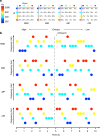Automatic and feature-specific prediction-related neural activity in the human auditory system
- PMID: 31371713
- PMCID: PMC6672009
- DOI: 10.1038/s41467-019-11440-1
Automatic and feature-specific prediction-related neural activity in the human auditory system
Abstract
Prior experience enables the formation of expectations of upcoming sensory events. However, in the auditory modality, it is not known whether prediction-related neural signals carry feature-specific information. Here, using magnetoencephalography (MEG), we examined whether predictions of future auditory stimuli carry tonotopic specific information. Participants passively listened to sound sequences of four carrier frequencies (tones) with a fixed presentation rate, ensuring strong temporal expectations of when the next stimulus would occur. Expectation of which frequency would occur was parametrically modulated across the sequences, and sounds were occasionally omitted. We show that increasing the regularity of the sequence boosts carrier-frequency-specific neural activity patterns during both the anticipatory and omission periods, indicating that prediction-related neural activity is indeed feature-specific. Our results illustrate that even without bottom-up input, auditory predictions can activate tonotopically specific templates.
Conflict of interest statement
The authors declare no competing interests.
Figures




References
Publication types
MeSH terms
LinkOut - more resources
Full Text Sources

